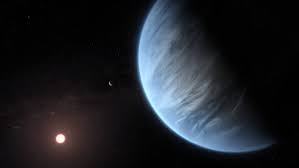New Habitable Exoplanet Mini Neptune 24
New Habitable Exoplanet
The detection of Gliese 12b, a super-Earth exoplanet circling a cold red dwarf star, by NASA’s Transiting Exoplanet Survey Satellite (TESS) is a ground-breaking discovery. Because of its possible habitability, astronomers and astrobiologists are interested in this planet, which is around the same size as Earth and Venus. Precise measurements of the orbit and size of Gliese 12b have been made possible by the transit method used by TESS, which involves detecting the dimming of a star as a planet passes in front of it.

A new habitable exoplanet known as Mini Neptune is as big as Earth, and it’s orbiting a red dwarf star—stars that are stable and long-lived—which adds to the significance of this finding. The hunt for planets that are habitable has these stars as top priorities. The habitable zone, which includes Gliese 12b, is where conditions may permit the presence of liquid water, an essential component of life as we know it, due to the star’s relative proximity.
The James Webb Space Telescope (JWST), which intends to study the planet’s atmosphere, is eagerly awaited for follow-up observations. In order to gather more proof that the planet is habitable, these observations will concentrate on detecting the presence of important atmospheric constituents like carbon dioxide, methane, and water vapor.
The finding of Gliese 12b opens up new options for future study and exploration and represents a major advancement in our understanding of exoplanets and their potential to support life outside of our solar system.
The super-Earth exoplanet Gliese 12b, which is circling a M-type star, was discovered in 2024, according to NASA’s Transiting Exoplanet Survey Satellite (TESS). Given its size and the kind of star it circles, this important discovery expands the list of exoplanets known to exist. Gliese 12b orbits its host star at a distance of 0.0668 astronomical units (AU) once every 12.8 days, with a mass of around 3.87 times that of Earth.
It is well within the star’s habitable zone due to its close proximity, where conditions may be suitable for liquid water support and, consequently, life.
M-type stars, or red dwarfs, are smaller and cooler than our Sun, offering a stable and long-lasting environment for planets orbiting them. The discovery of a super-Earth in such a system is particularly exciting because red dwarfs are abundant in the galaxy, increasing the likelihood of finding similar potentially habitable planets.
Critical information about the size and orbital parameters of Gliese 12b is provided by the accurate measurements that TESS got through the use of the transit method. It is highly anticipated that future investigations by the James Webb Space Telescope (JWST) will examine the planet’s atmosphere, looking for essential elements including carbon dioxide, methane, and water vapor.
Follow our Digiknowledge.co.in page for the latest updates about technology, bikes, cars, sports, lifestyle, and many more.
In order to determine whether or not the planet is habitable and has the capacity to host life, these atmospheric investigations are crucial. An important step forward in our understanding of exoplanets has been made with the finding of Gliese 12b, which sheds light on the variety of planetary systems in our galaxy and the potential existence of extrasolar life.
Some more information about New Habitable Exoplanet Mini Neptune
As an exoplanet, Gliese 12b is intriguing to research further because it is similar in size to both Earth and Venus. In the constellation Pisces, it revolves around Gliese 12, a cold red dwarf star around 40 light-years away. Only about 27% of the size and 60% of the surface temperature of our Sun are found on Gliese 12, making it much smaller and colder than our Sun.
A great deal of interest has been sparked by the possibility that Gliese 12b is habitable. Around 107 degrees Fahrenheit (42 degrees Celsius) is thought to be the planet’s surface temperature in the absence of an atmosphere.
If the planet has a suitable atmosphere, liquid water may exist on its surface based on this temperature range. Gliese 12b orbits at a mere 7% of Earth’s distance from the Sun, which is extremely near to its host star. Because of this, it gets around 1.6 times as much energy from Gliese 12 as Earth does from the Sun.
The aforementioned features render Gliese 12b a noteworthy subject of investigation in the quest for exoplanets that may be habitable. Determining if this far-off world may harbor life will require more studies, especially of its atmosphere.
Conclusion
A major turning point in the study of astronomy and the hunt for extrasolar life has been reached with the discovery of New Habitable Exoplanet Mini Neptune, a habitable exoplanet. Mini Neptune provides a rare chance to study a planet that sits between Earth and the gas giants of our solar system, with a radius around 2.5 times that of Earth and a mass nearly ten times larger. It is located in a habitable zone where circumstances could support liquid water due to its near orbit around a K-type or M-type star, which it completes once every 30 days.
Its surface temperature, which may be similar to Earth’s, and its atmospheric composition—which may be rich in water vapor, hydrogen, and helium—make it a more desirable target for future research.
Its powerful magnetic field and potentially shielding atmosphere could produce stable circumstances conducive to life, despite its higher gravity and atmospheric pressure.
We will be able to learn more about New Habitable Exoplanet Mini Neptune’s atmospheric characteristics and general habitability as observational technology develops, especially with instruments like the James Webb Space Telescope. In addition to enhancing our knowledge of planetary systems, this exoplanet advances our search to find the answer to the age-old query of whether or not we are the only life on Earth.
Why are New Habitable Exoplanet mini-Neptunes not likely to be habitable?
An inner core of rock and iron is assumed to surround a layer of high-pressure water on a mini-Neptune, which is predicted to have a sizable hydrogen envelope. Should this envelope be excessively thick, the temperature would be excessively high, and the pressure at the water layer’s surface would be excessively high to sustain life.
Do New Habitable Exoplanet mini-Neptunes have water?
There might be an atmosphere or ocean on the recently found “mini-Neptune,” but only temporarily. Ultimately, the planet will either become a naked, stony planetary core or a rocky core coated in oceans.
What exoplanets are similar to Neptune?
The eptunian exoplanets are similar in size to Neptune or Uranus in our solar system. Neptunian planets typically have hydrogen- and helium-dominated atmospheres with cores of rock and heavier metals. Neptunian exoplanets are similar in size to Neptune or Uranus in our solar system.




